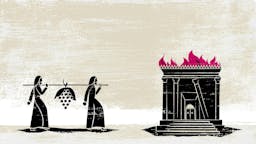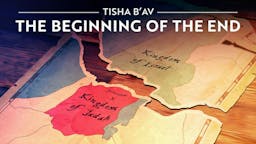Tisha B'Av: Mourning vs Moral Reflection
On Tisha B'Av we're asked to mourn our losses - and grow from them. How can we hold both at the same time?
By Tikva Hecht | 24 July 2025 | 5 Minute Read
The Two Sides of Tisha B'Av
On Tisha B’Av, I often feel as if I’m being pulled in two opposite directions.
On the one hand, it’s a day of grieving. We’re longing for the Beit Hamikdash. And remembering all the tragedies and loss that have marked our history. We’re crying out to God from the depths of a collective national sorrow and just hoping to be heard.
On the other hand, there’s a more moralistic side to Tisha B’Av. We talk about sinat chinam and avodah zorah, and the role we played in bringing about the destruction of the Temples. And we consider what we can learn from our mistakes in order not to repeat them.
So is Tisha B’av about lamenting our wounds or reckoning with our hand in causing them?
Honestly, even writing that sentence makes me uncomfortable. I understand the value of self-reflection. A deep part of our tradition is to see ourselves as moral agents, able to influence the course of history. But still, to look back at horrible tragedies – no matter how long ago they occurred – and wrestle with our culpability, while also re-experiencing the immediacy of mourning… It seems like too much to ask.
There’s a natural impulse in mourning to resist the critical sting of reflection. And a risk with even the best intended reflection that it will make you callous to the pangs of mourning. How are we supposed to do both at the same time?
A Time for Mourning and a Time for Reflection
I was thinking about this problem while looking over Aleph Beta’s Tisha B’Av library, and I noticed something. You can almost slice the offerings down the middle.
There’s what you might call the life lesson courses. These look at key moments leading up to the chorban, or related texts, and ask what happened – how might history have gone differently and what can we learn from that? These videos offer nuanced takes on the missteps of the past to prompt self-reflection and hopefully action. And they account for about half the collection.
But then there’s the other half. These have a very different tone. They reflect on the experience of mourning and the theological angst that can bring. They ask questions like why does God allow suffering. And, as in the video from last year, the first one after October 7th, they wrestle with how to connect to God from a place of darkness. These videos aren’t about teaching a lesson, but about navigating the emotional intensity of this day with greater meaning and faith.
And when I noticed this divide… that’s when it hit me. Tisha b’av is really long.
It’s not a moment of silence. It’s 25 hours of fasting and focus. We don’t need to hold everything at the same time. There’s space in the day to give each nuance its due and on its own terms. Space to sit with our own suffering, and space to reflect on our actions. To look back with compassion. And to look ahead with conviction.
Not all at once, but hour by hour, we can experience the whole range of what Tisha B’Av is meant to be.
If what I’m describing speaks to you, here’s a quick guide to help you experience some of our videos from these two lenses. You can pick and choose a few, or watch the lot and fill your whole afternoon.
Learning from the Past

How The Sin Of The Spies Led To Tisha B’Av
Video series • Part 1 of 6 • 10 min
The first recorded tragedy of the 9th of Av occurred hundreds of years before the first Beit HaMikdash was even built. This surprising origin story sheds a whole new light on the meaning of the day.

Was God Toying with Solomon?
Video • 7 min
God gave King Solomon unprecedented wisdom, which Solomon used to build a glorious kingdom. But just a mere generation later, that kingdom splits and the road to Tisha B’Av begins. Why didn’t God give Solomon the wisdom he really needed… the wisdom to keep Israel united?

Tisha B'Av after the Iran War
Video series • Part 1 of 7 • 12 min
Israel's victory over Iran feels like a pivotal historical moment. But it's not the first time that the Jewish nation has faced a situation like this one.

Kamtza And Bar Kamtza: What Is Baseless Hatred, Anyway?
Video series • Part 1 of 5 • 3 min
When was the last time that you hated someone for absolutely no reason? Could it be we’ve been misunderstanding the true meaning of “baseless hatred” this whole time?



